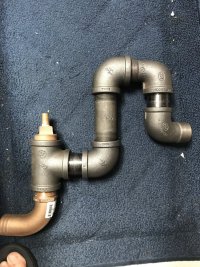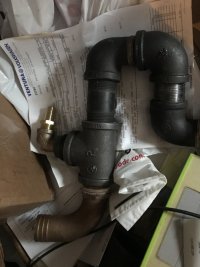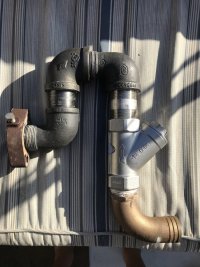LeifThor
Member III
1972 Ericson 35-2.
Atomic 4 engine under seatee in lounge area.
Blower (working great) sucks air from bilge area under engine, opening is 4-5 inches from transmission box, exits out starboard stern side through cowling.
Cowling providing air intake on port stern side (so a flow of air in air out around the engine) 3 inch blower hose end at front top of engine on the left side.
SOOOO, in theory there should be a nice circulation of air running from the top of the engine compartment over the engine, and then getting sucked out the other end of the engine just underneath so the air is being replaced with outside cool air to help cool the engine roughly every 30 seconds.
Then the more I thought about it, I realized in totality there's a huge air cavity from which the air getting sucked out, so it could simply use that air bypassing the cowling vent providing replacement air, meaning you think the engine is getting cooled, but it's not, instead it's sucking the air from behind the cabinet behind the stairs.
I tried running the blower using incense on the intake side and there was 0 suck, no smoke going in.
I realized there were more than a few air holes to help in ventilation (top of cabinet behind stairs, side of rear quarter berth bed, and in my particular case gaps between the wood housing around the engine (part of the seatee) and the fiberglass sole of the boat which comes up 5 inches from the floor.
I plugged every one of them, and still zero suck from the air intake side.
In theory, if there's a large hole to pull air in from, it would use that large hole, or if there's holes closer to the vacuum end it might draw the air from there.
What puzzles me, is the way the engine compartment is where there's no air containment, or the air in the engine compartment is also the same air cavity behind the cabinet behind the stairs, the large locker on the starboard side of the cockpit, the cabinet under the sink...If I were to fill the cavity with water it would be hundreds of gallons, instead of the 20 the engine compartment alone takes up.
This feels like bad design, and I hate to say that as I love my Ericson so much and find so much of it's design impeccable. But here, in short it's terrible as there's a far more likelihood the air will get sucked from everywhere but the engine compartment as it's a much easier place to get the replacement air from.
And there's no way I can see to fix this, or there's no way to partition off the engine area, so it's forced to suck the air from the outside vent/cowling on the port side so an airflow can exist to run over the engine so it can cool down.
I should add, when my atomic is running she cools beautifully! You can put your hand directly on the engine and it's luke warm. It's only when the engine is turned off, it becomes quite hot and hot in the engine compartment. It gets so hot, it's slightly melted the cushion on top (through the cracks between the engine cover the remainder of the seetee).
In the past, I've simply removed the cover so it can cool freely. Now I've got a new lounge single piece, so I need to address the blower cooling system.
Any ideas anyone?
Atomic 4 engine under seatee in lounge area.
Blower (working great) sucks air from bilge area under engine, opening is 4-5 inches from transmission box, exits out starboard stern side through cowling.
Cowling providing air intake on port stern side (so a flow of air in air out around the engine) 3 inch blower hose end at front top of engine on the left side.
SOOOO, in theory there should be a nice circulation of air running from the top of the engine compartment over the engine, and then getting sucked out the other end of the engine just underneath so the air is being replaced with outside cool air to help cool the engine roughly every 30 seconds.
Then the more I thought about it, I realized in totality there's a huge air cavity from which the air getting sucked out, so it could simply use that air bypassing the cowling vent providing replacement air, meaning you think the engine is getting cooled, but it's not, instead it's sucking the air from behind the cabinet behind the stairs.
I tried running the blower using incense on the intake side and there was 0 suck, no smoke going in.
I realized there were more than a few air holes to help in ventilation (top of cabinet behind stairs, side of rear quarter berth bed, and in my particular case gaps between the wood housing around the engine (part of the seatee) and the fiberglass sole of the boat which comes up 5 inches from the floor.
I plugged every one of them, and still zero suck from the air intake side.
In theory, if there's a large hole to pull air in from, it would use that large hole, or if there's holes closer to the vacuum end it might draw the air from there.
What puzzles me, is the way the engine compartment is where there's no air containment, or the air in the engine compartment is also the same air cavity behind the cabinet behind the stairs, the large locker on the starboard side of the cockpit, the cabinet under the sink...If I were to fill the cavity with water it would be hundreds of gallons, instead of the 20 the engine compartment alone takes up.
This feels like bad design, and I hate to say that as I love my Ericson so much and find so much of it's design impeccable. But here, in short it's terrible as there's a far more likelihood the air will get sucked from everywhere but the engine compartment as it's a much easier place to get the replacement air from.
And there's no way I can see to fix this, or there's no way to partition off the engine area, so it's forced to suck the air from the outside vent/cowling on the port side so an airflow can exist to run over the engine so it can cool down.
I should add, when my atomic is running she cools beautifully! You can put your hand directly on the engine and it's luke warm. It's only when the engine is turned off, it becomes quite hot and hot in the engine compartment. It gets so hot, it's slightly melted the cushion on top (through the cracks between the engine cover the remainder of the seetee).
In the past, I've simply removed the cover so it can cool freely. Now I've got a new lounge single piece, so I need to address the blower cooling system.
Any ideas anyone?



